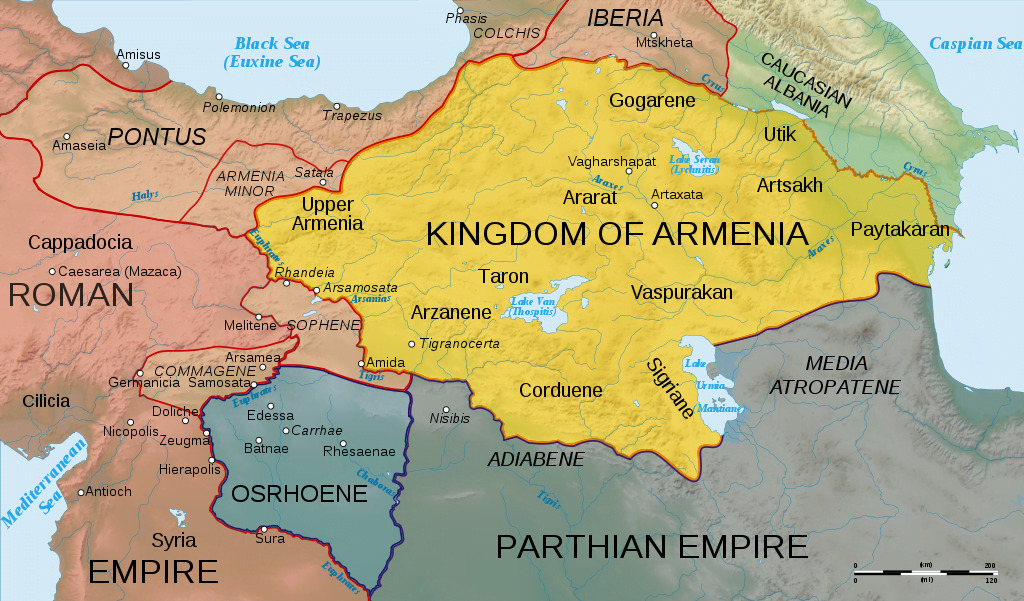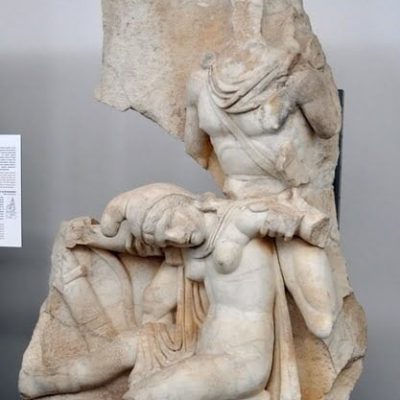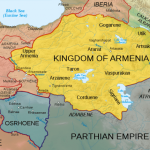Chapters
Gnaeus Domitius Corbulo (Gnaeus Domitius Corbulo) was born around 7 CE in Peltuinum (now S. Paolo di Peltuino in Italy). He was a Roman commander, brother-in-law of Emperor Caligula and father-in-law of Domitian. He was famous for his victories in Lower Germany (today’s Netherlands) and in the conflict between Rome and the Party over Armenia.
Background, family and early career
Corbulo came from a senatorial family. His father of the same name entered the senate during the reign of Emperor Tiberius and served as praetor. His mother, Vistilia, also came from a good line, where one of the family members took the pretense.
Corbulo’s wife was Cassia Longina, a senatorial woman, daughter of Gaius Cassius Longinus. They had two daughters: the elder Domitia, who married senator Lucius Annius Vinicianus, and Domitia Longina, who later became the wife of Emperor Domitian. Both daughters were direct members of the Julio-Claudian Dynasty.
Corbulo’s early career and life are unknown. It is certain that in 39 CE he took over the consulate during the reign of Caligula. The ruler was his brother-in-law, as Corbulo’s half-sister Milonia Caesonia became empress.
Command in Germania
After the murder of Caligula, Corbulo’s career came to a halt for a while. Only in 47 CE Emperor Claudius appointed him commander of the troops in Lower Germania (Germania Inferior). The headquarters of the command staff was Colonia (Cologne) . Corbulo had under his command legions: V Alaudae and XV Primigenia in Xanten, XVI Gallic aw Neuss and I Germanica in Bonn. During his tenure as a title, Corbulo had to deal with the rebels of the Germanic Cheruski and Chauk tribes. At that time, i.a. ordered the excavation of a canal connecting the Rhine with the Meuse called Fossa Corbulonis or the Corbulo Canal. Archaeologists have confirmed the existence of this structure.
In the end, Corbulo managed to defeat the Germanic tribes, which he owed to organized military operations and the discipline he introduced in the legions. The commander was said to have sentenced to death two legionaries who put their swords aside during the construction of the marching camp. He was also supposed to ridicule the soldiers, claiming that they would fight with pickaxes if they were unexpectedly invaded by an enemy.
Expedition to the East
After subduing the German rebellion in the northern part of the Empire, Corbulo returned to the capital, where he stayed until 52 CE. It was then that he was appointed governor of Asia (Western Turkey) – a wealthy Roman province.
However, in 54 CE Claudius died, and young Nero took his place. The new ruler sent Corbulo to the east of the empire, with a role that was not entirely clear. Corbulo, as it turned out, was to personify Rome’s more aggressive policy in the east. Corbulo appears to have taken over as Independent Commander in Cappadocia.
Competing with the Party
In the east, Rome’s main enemy was invariably the Party, which, like Rome, tried to maintain its influence in the client state of Armenia. Under the agreement of Octavian Augustus and the party ruler Phraates IV, the Romans had the right to nominate and crown rulers on the throne of Armenia. However, in 54 CE king Vologazes I of the Party, taking advantage of the internal crisis in Armenia and the change on the Roman throne, established his brother Tiridates I as the ruler of the puppet state. The situation in the east grew hotter.
In the east, apart from Corbulo (he had the III Gallica and VI Ferrata legions under him), also commanded the governor of the Syria province – Gaius Durmius Ummidius Quadratus – who had two legions under their control: X Fretensis and XII Fulminata.
At the request of both commanders, the Parthian king handed over prisoners of war to the Romans. Thus, the war was postponed, which in turn was used by the Romans to strengthen their forces. In addition, there was a not entirely clear conflict between Corbulo and Ummidius – probably about which of them is to take the prisoners.
In 56 CE to the east came the legion III Scythia from the Danube. Corbulo undertook to improve morale and discipline in the Roman ranks and strenuous training. In 58 CE the army of the king of Armenia, Tiridates, attacked the unprepared Roman army. With subsequent clashes, the Romans were dragged deep into Armenia. In the meantime, the Caucasus tribes fought against the Armenians, which gave the legions III Gallica, VI Ferrata and X Fretensis a chance to start a siege of Artaxata (now Yerevan) – one of the capitals of Armenia. At the same time, a Hyrcan revolt broke out against the Parthian rule. It is possible that the coincidence was not accidental and the Romans deliberately encouraged the rebellion. Faced with such a situation, Party King Vologazes could not help his brother and Artaxata was conquered by the Romans.
In 59 CE, the Romans crossed the hot deserts of Mesopotamia and the Tigris and headed for Tigranocerta, Armenia’s second capital. The city surrendered before the siege took place, and Nero was able to proclaim his complete success. Tigranes, a faithful servant of the Romans, was placed on the throne of Armenia. Tigraness spent a long time in Rome as a royal hostage, which led to the development of a far-reaching submission in Tigranes, which the Roman historian Tacitus compared to that of a slave.
The Romans realized that this was not the end of the struggle for Armenia and gradually strengthened their forces in the region, including Tigranes VI was given a garrison of 1,000 legionaries, three auxilia cohorts and two cavalry units. Moreover, in 61 CE the V Macedonica legion appeared in Armenia. The same year, Wologazes suppressed the Hyrcan rebellion and proclaimed his brother Tiridates king of Armenia, while Tigranes, on the orders of the Romans, invaded Adiabene – a kingdom subordinated to the Parthians and ruled by Monobazes II. The Parthians considered this a violation of peace terms and attacked Armenia.
In the spring of 62 CE, there was another war. The Parthians set out to lay siege to Tigranocerta. The Romans planned to trap the Party troops between their two armies and annihilate them completely; however, the incompatibility of the commanders meant that there was only a temporary truce and the postponement of the siege of the capital of Armenia.
In the summer of the same year, Lucius Caesenius Petus, the Roman commander and governor of Cappadocia, who also served as the consulate of the previous year, appeared in the region. He had the legions V Macedonica, IIII Scythica and XII Fulminata under his command, where he set off for Armenia with the last two.
At the same time, Corbulo crossed the Euphrates and entered Mesopotamia. It was then that the news of the defeat of Petus, who had fallen into a trap set by the Parthians at Arsamosata, found him. Petus – judged to be an incompetent commander – surrendered to Rhandea and pledged that Armenia would be returned to Tiridates. He took the throne in 63 CE.
Then Korbulon took over command of the legions (III Gallica, V Macedonica, VI Ferrata and the newly formed XV Apollinaris). In 63 CE, at the head of a large army, he crossed the Euphrates. The Parthian king, fearing a skirmish with the Romans, decided for peace. On the side of the Romans, the treaty was negotiated by the Egyptian Jew – Tiberius Julius Alexander. Under it, the Romans undertook not to fight any further, and the Parthians to refrain from any claims for the throne of Armenia. Tiridates could receive the crown of Armenia only with the consent of Nero.
The victory was welcomed in Rome with great cheers, and Nero bestowed great honors on Corbulo. Moreover, the gates of the Temple of Janus were closed as a sign of the coming of peace. It is worth noting that Corbulo was said to have written memoirs from the expeditions to the east. The work, however, has not survived to our times.
Death
In the 60s of the first century CE Corbulo has been partly involved (wrongly) in conspiracies to overthrow Nero. One of the accused was his son-in-law, Lucius Annius Vinicianus,, who in 62 CE he planned an assassination attempt on the emperor. Nero’s suspicion grew so much that the emperor began to look more closely at Corbulo, who enjoyed great popularity among the masses.
In 66 CE, when unrest broke out in Judea and Vespasian took command of the army, Nero summoned Corbulo to Greece. In the port of Corinth – Cenchreae – Corbulo received information from the messenger Nero about the order to commit honorable suicide. Corbulo, as the ruler wished, threw himself at the sword, shouting Axios! (Worthy!).










